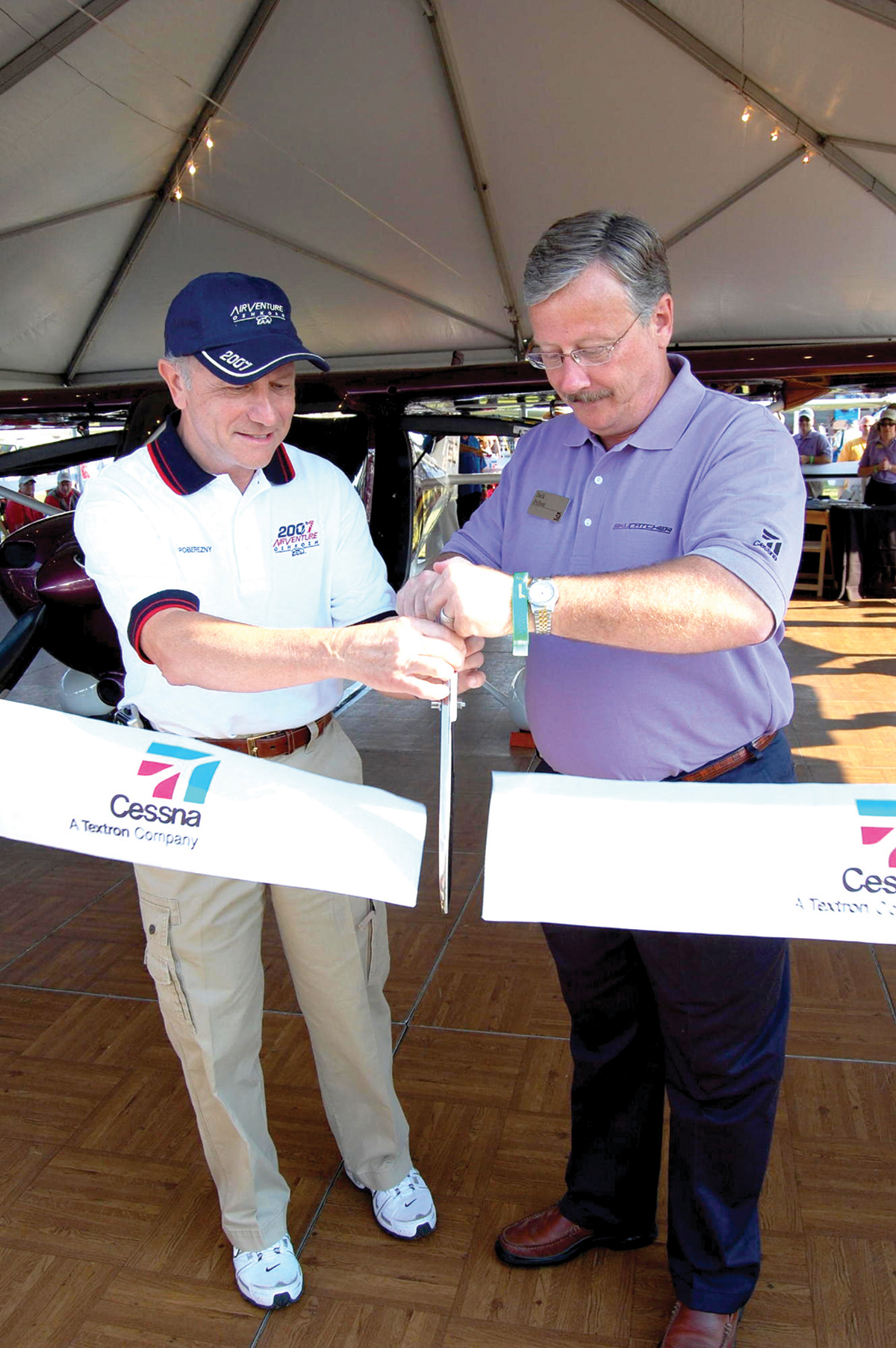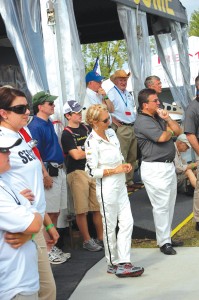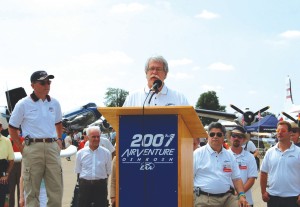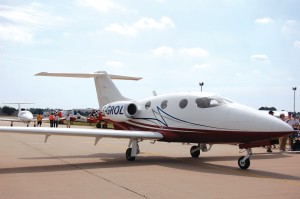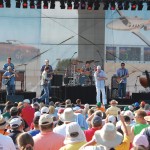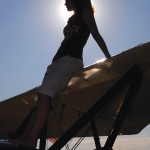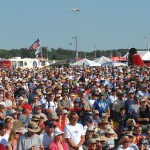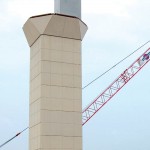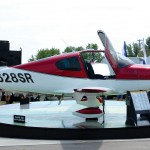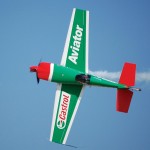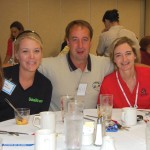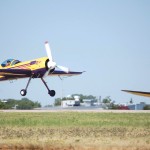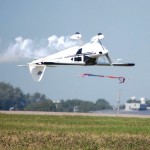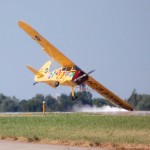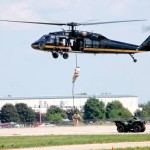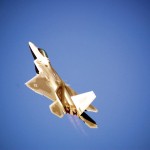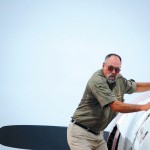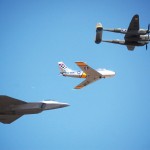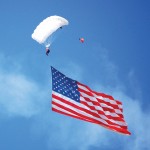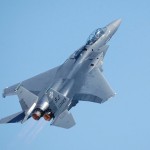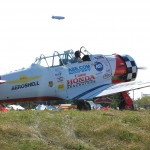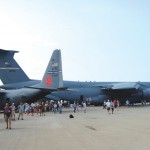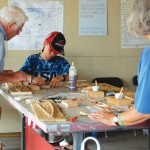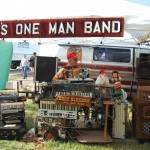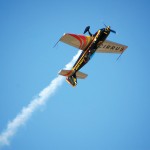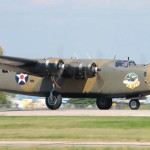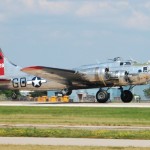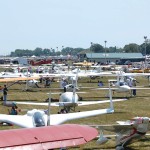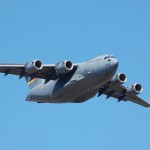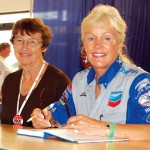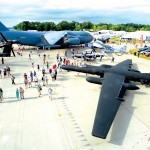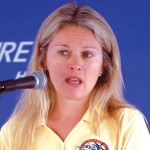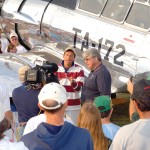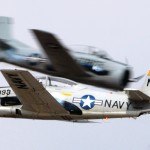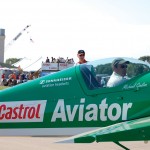By Henry M. Holden
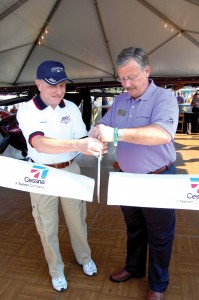
Tom Poberezny and Cessna CEO Jack Pelton cut the ribbon to introduce the new C-162 SkyCatcher. The release of this light sport aircraft promises another chapter in Cessna’s history of teaching the world to fly.
The 55th annual seven-day EAA AirVenture Oshkosh gathering, known as “The World’s Greatest Aviation Celebration,” opened on July 23. Each year seems to top the previous in aviation advances, legacy and enjoyment. This year AirVenture welcomed more than 10,000 aircraft into Oshkosh-Wittman Regional Airport (OSH) and other nearby fields; 2,617 show airplanes, including homebuilt, ultralights, vintage, and seaplanes were exhibited. An estimated 560,000 visitors from 65 countries attended.
“Simply put, Oshkosh is the place for anyone who enjoys flight, innovation and the best aviator’s gathering in the world,” said Tom Poberezny, Experimental Aircraft Association president and AirVenture chairman.
LSA Market Expands
This year’s show featured a plethora of new light sport aircraft and very light jets. After considerable efforts headed by the EAA, the Federal Aviation Administration established the sport pilot/light-sport aircraft rule three years ago. Since then, the new category has grown at a rapid rate. There are 2,100 new sport pilots, 232 certified SP instructors and 240 SP pilot examiners. The FAA has given nearly 3,700 SP written tests.
The movement has helped airplane enthusiasts learn how to fly and gain access to aircraft for half the cost and in half the time of previous alternatives. Manufacturers, suppliers, instructors, mechanics and potential pilots who had been watching the fledgling LSA market are now seizing upon these new opportunities.
Cessna Aircraft Co.—celebrating its 80th year in aviation, with more than 190,000 airplanes produced—hit a home run on opening day with its new LSA, the Model 162 SkyCatcher.
“Cessna has taught the world to fly, and today we’re introducing another product that will continue to teach the world to fly for the next 80 years,” said Jack Pelton, Cessna chairman, president and CEO.
The aluminum-made Cessna LSA will sport the Continental O-200D engine, an exclusive single-screen Garmin G300 avionics, two-blade composite prop, caster nosewheel, adjustable rudder pedals, painted metal interior and gull-wing doors. A significant change from the proof-of-concept airplane is a constant chord wing, which makes it easier to manufacture. The plane is expected to cruise up to 118 knots and have a maximum range of 470 nautical miles and a 15,500-foot service ceiling. Preliminary specifications of the day/night VFR-capable airplane include a 1,320-pound maximum takeoff weight, a 490-pound useful load and a 24-gallon useful fuel load. A conforming prototype is expected to be flying by next summer with ASTM certification planned by year-end 2008. First deliveries are expected in the second half of 2009.
EAA is the launch customer for the new Cessna model.
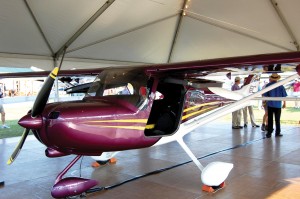
SkyCatcher, an aluminum LSA, has a Continental O-200D engine, single-screen Garmin G300 avionics, two-blade composite prop, caster nosewheel, adjustable rudder pedals, painted metal interior and gull-wing doors.
The second delivery will be made to the EAA Flight Academy. Cessna is working on an FAA/Industry Training Standards approved SkyCatcher flight-training program for both sport and private-pilot courses.
Cessna was taking $5,000 deposits at the show, and Pelton expected many orders from Cessna Pilot Centers since the airplane is targeted toward the training market. By Thursday, Cessna reported 570 orders placed at AirVenture. Priced at $109,500, that’s more than $62 million in orders.
On July 23, Duluth, Minn.-based Cirrus Design Corp. unveiled its new LSA, the Cirrus SR Sport. After capturing the crowd’s attention, with a bit of dramatic flair, Alan Klapmeier, Cirrus chairman and CEO, pulled the parachute off the plane, revealing the SRS.
“We began with an existing design based on the Fk14 Polaris,” he said.
Fk Lightplanes, of Speyer, Germany will manufacture the two-seat SRS.
“We’ll ‘Cirrusize’ the SRS,” Klapmeier said. “We’ve been looking at how to make a lower-cost plane. We didn’t have time to design an LSA, but we wanted to introduce one.”
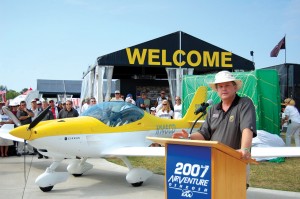
Alan Klapmeier introduces Cirrus Design’s latest offering, the two-seat, all-composite SRS. They plan to offer the SRS to the light sport aircraft market in the near future.
A 100-hp Rotax 912S engine powers the low-wing aircraft. Cirrus said the all-composite SRS would be equipped with the Cirrus Airframe Parachute System and have an all-glass cockpit. Cirrus donated the aircraft to be auctioned at the Gathering of Eagles dinner. Hal Shevers, Sporty’s Pilot Shop founder, had the winning bid of $170,000. The proceeds benefit the Young Eagle’s pilot outreach program. EAA should see its SRS delivery next summer. The SRS is expected to cost around $100,000, but a firm price hasn’t been announced.
According to Cirrus, the SRS will be an extension of the company’s current product line for people who would like a Cirrus aircraft but are more interested in sporty, recreational or entry-level missions.
“For years we’ve talked about how we as an industry needed to introduce more people to flying,” said Klapmeier. “The SRS is another example of us providing a high customer value product that is easier to fly, more comfortable and loaded with safety features—all at an extremely affordable cost.”
The SRS conforms to the European microlight standards but not (yet) to the American Society for Testing and Materials standards for an LSA. Some of the modifications Klapmeier shared include changing the current hand-operated brakes to toe brakes and changing the current nose wheel to the same castering type of the SR20 and SR22.
On Tuesday, CubCrafters Inc. announced their second generation “Sport Cub S2.” With more than 100 specific design improvements, new standard features and new optional equipment, the Sport Cub S2 appears to improve safety, performance, utility and comfort over its predecessor.
The Sport Cub S2 will be a 100-hp, two-place LSA with a minimum useful load requirement of 450 pounds and a maximum empty weight of 890 lbs, including all standard and optional equipment. Two wing fuel tanks holding 12.5 gallons each will provide a range of 450 miles. The base price is expected to be $119,500.
Todd Simmons, vice president of CubCrafters, noted the importance of this new airplane to the legacy of the Cub design.
“The first Cub was born nearly 70 years ago, and in the following decades more than 40,000 of those airplanes were produced,” Simmons said. “Twenty-seven years ago, CubCrafters founder Jim Richmond picked up where Piper left off. Jim’s work quickly became the recognized industry standard for Super Cub restorations and modifications.”
In just the last four years, CubCrafters introduced both the original LSA-category Sport Cub, and its big brother, the FAR Part 23 certified Top Cub.
Today’s announcement revealed that the company has incorporated everything they know about Super Cubs into Sports Cub S2.
“Why improve so much on the original?” Simmons asked. “The light sport segment is now firmly entrenched in aviation and it’s been legitimized by so many significant industry players.”
The new Sports Cub S2 is a combination of more than 40 new carbon fiber and composite parts. It gains an increase in horsepower via the “4 into 1” exhaust system. It has stronger and lighter weight materials, such as an updated tail spring, new lightweight double puck brakes, calipers and lighter but stronger windows. The result of these changes is reduced empty weight, increased payload, reduced takeoff and landing distances and increased climb performance. CubCrafters validated the Sport Cub S2 “Performance Package” in the Carbon Cub, POC airplane that took off in just 19 feet at the Valdez May Day Fly-in & Airshow this year.
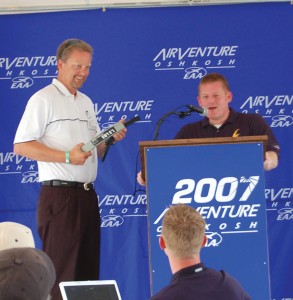
Todd Simmons, CubCrafters vice president, asks Dale Klapmeier (left) Cirrus cofounder and vice chairman of the board, to compare the lightweight carbon fiber part with a similar composite part used on the new CubCrafters LSA S-2.
“A design goal that we achieved in the original Sport Cub and that we’ve improved on the Sport Cub S2 is giving our customers the most capability and flexibility of any LSA aircraft, while in full compliance with LSA certification requirements,” Simmons said.
VLJ Announcements
Opening day saw competition to catch attention before the exhibit doors opened at 9 a.m. At 8:30, Eclipse Aviation Corp. surprised media when Vern Raburn, president and CEO, taxied up to the company’s exhibit and stepped out of its V-tail, single-engine Eclipse Concept Jet.
Demonstrating the fever pitch embracing the industry, the single-engine podded jet went from concept to flight in six months. Its specs include a maximum cruise speed of 345 knots, service ceiling of 41,000 feet and a 1,250-nautical mile range. It stalls at 61 knots and has a fuel tank capacity of 186 gallons.
“We did it again,” Raburn declared to the assembled press corps and onlookers.
He stressed to the audience that it wasn’t a product launch, but a “concept aircraft.” The four-seat VLJ shares about 60-percent commonality with the certified Eclipse 500. Contractors Swift Engineering and Basis built the aircraft in secret surroundings at NASA’s Wallops Island Facility in Virginia. The plane’s pod-mounted engine is a Pratt & Whitney Canada PW610F.
According to the company, the all-aluminum ECJ has logged about 30 flight hours since its first flight on July 2. The airplane has reached speeds of 250 knots and altitudes up to 25,000 feet. Preliminary weights include a 4,800-pound maximum takeoff weight, a 2,480-pound empty weight and a 2,000-pound useful load.
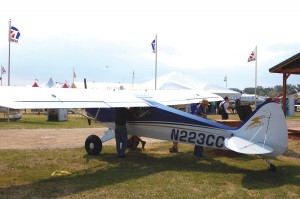
CubCrafters’ Sport Cub S2 will be a 100-hp, two-place LSA with a minimum useful load requirement of 450 pounds and a maximum empty weight of 890 lbs. The base price is expected to be $119,500.
“The Eclipse Concept Jet will allow us to obtain real, quantifiable data that looks at this developing category,” Raburn said. “While today we have no production plans for the ECJ, we are constantly evaluating markets for future Eclipse products. We’re anxious to reveal the potential of this emerging category, and an opportunity to add real value to it.”
Raburn says that his company will make a go/no-go decision for the ECJ’s official launch in the next year, and he noted that the VLJ doesn’t yet have a model number. While Eclipse didn’t reveal any pricing for the ECJ (nor is it taking deposits now), Raburn estimates that it would probably cost about $1 million.
Later in the week, Raburn said the response to the ECJ has been spectacular.
“It has far exceeded our expectations,” he said. “The most common reaction from pilots who climb into the cockpit of the mock-up is, ‘This is the airplane I always wanted.’ It elicits a very emotional response. It’s staggering.”
Eclipse held another press conference on Wednesday morning to talk about the Eclipse 500 twin-engine VLJ program. The 500s now on the assembly line will have a new color weather radar system made by Japan Radio Company, rather than Honeywell’s system. The JRC system will be more accurate and more reliable, he said.
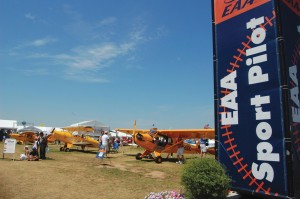
The Light Sport Aircraft Mall has become a busy place in the last three years. There are 2,100 new sport pilots, 232 certificated sport pilot instructors and 240 SP pilot examiners.
On Monday, Epic Aircraft unveiled two prototype jets, proving it has a development schedule as aggressive as its marketing campaign. The single-engine, all-composite Victory arrived right behind the Elite twin for a 10:30 a.m. press conference. Rick Schrameck, Epic president and CEO, referred to AirVenture 2007 as Epic’s first “family vacation.”
In an emotional tribute to the dedication of the aircraft’s design and production team, Schrameck told onlookers that 202 days from the first AutoCAD entry, the Victory was a flying jet.
“These guys did magic,” he said. “The first piece of work in the CAD (computer-aided design) system was completed on Dec. 15, 2006. We were aiming for flight-testing on July 4, but Mother Nature ruled that out.”
The Victory’s first flight was on July 6.
“The folks at Williams International worked tirelessly with us to get the Victory up and flying in a record amount of time,” Schrameck said.
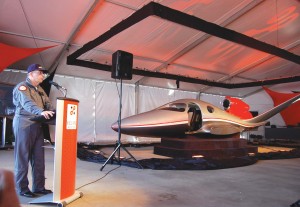
The Eclipse Concept Jet, introduced by Vern Raburn, Eclipse Aviation president and CEO, is capable of 370 knots and climbs to 41,000 feet. Eclipse is currently using the ECJ for market research.
Owner-built versions of the Victory will fly with the Pratt & Whitney 615 turbofan later this year. Epic promises to deliver at least five of the new jets to customers before year-end 2007.
The Victory will first be available as an owner-built aircraft via the company’s Customer Build Center in Bend, Ore.
“The Victory and the Elite set the bar for VLJs,” said a smiling Schrameck. “VLJs are supposed to be state of the art, capable of single-pilot operation and have jet performance. These two aircraft are all of that and more.”
Each aircraft has about 50 hours of flight-testing. The Victory is powered by a Williams FJ33-4A engine and will have a top cruise speed of 320 knots and a 28,000-foot service ceiling, according to the company. The price for the certificated version of the Victory is expected to be between $1.3 million and $1.5 million, while the experimental version will be about $1 million.
The Epic Elite will seat six to eight people, depending on the interior configuration. Powered by two Williams FJ33-4A engines, the Elite’s maximum cruise speed is expected to be around 412 knots, with a service ceiling of 41,000 feet. The price for the certificated production version will be around $2.35 million. Its experimental sister ship will be priced near $1.5 million.
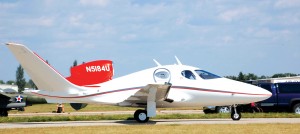
The four-seat Eclipse Concept Jet shares about 60 percent commonality with the Eclipse 500. The single-engine, podded jet went from concept to flight in six months.
Consistent with the Epic Aircraft business model, the Elite will first be available in 2007. The certified version of the Elite is expected in late 2009.
Schrameck said that the experimental category is essential to the success of his company, as it is to Oshkosh.
“My roots are in aviation,” he said. “We’re all EAAers here. We’re experimental builders; I’ve personally built and raced more than one experimental aircraft at Reno.”
Bob Kromer, vice president of sales at The New Piper Aircraft Inc., discussed its new VLJ. The PiperJet will cruise at more than 300 knots and glide almost as well as some gliders, according to the company. A one-fifth-scale model of the jet recently completed wind-tunnel evaluation. The wind-tunnel tests mandated design changes including a new wing root fairing and a 30-degree sweep on the horizontal stabilizer.
“The results not only validated the basic design but revealed a surprise,” Kromer said. “The high aspect ratio of the wing appears to give the jet a 17:1 glide ratio and adds to the overall safety of the aircraft.”
He said the aircraft is well suited to cruise between 25,000 and 31,000 feet. At 35,000 feet, the jet will cruise at 360 knots and have a 1,300-nm range.
Kromer said there’s been no decision on where the airplane will be built. Its current home of Vero Beach, Fla., is competing with Oklahoma City and Albuquerque, N.M., for the PiperJet plant and the company’s piston and turboprop manufacturing. Certification is set for mid-2010 with first deliveries by year-end 2010.
DA50 SuperStar: filling a niche
Diamond Aircraft Industries formally unveiled its DA50 SuperStar to the North American market at AirVenture. The aircraft is intended to fill the niche between the excess of four-place high-performance singles and the in-development personal jets.
“We saw a gap in the market,” said company spokesperson Heike Larson. “This is different from what’s out there.”
With a 52-inch-wide cabin and a full range of creature comforts, including backseat entertainment screens for three in its aft bench seat, the DA50 seats an average-sized family. Larson said the SuperStar is aimed at those who want a big, high-performance load hauler. Ice protection and a BRS parachute will be available options. Powered by a 350-hp turbo-charged Continental TSIOF-550J engine with FADEC, the DA50 has a 200-knot cruise speed, 900-nautical-miles range and a certified maximum flight ceiling of 25,000 feet. The plane is estimated at $600,000.
Lancair’s Evolution
After several years of development, Lancair International Inc. unveiled its most technologically advanced kit plane at AirVenture. The Evolution is a 338-knot, four-place pressurized aircraft that employs virtually all the latest state-of-the-art avionics, safety and performance innovations. According to the company, although the plane is fast, the Evolution is designed with the average pilot and builder in mind.
“We tried to make the safest airplane possible,” said Tim Ong, Lancair spokesperson.
The Evolution is equipped with a parachute recovery system and AmSafe airbag seatbelts.
“It’s also designed to FAR Part 23 standards, so it stalls at 61 knots,” Ong said. “The kit is designed with as many systems as possible integrated into the composite structures to make building easier and faster. The cost will be about $250,000 for the kit, minus the engine.”
The aircraft is designed for a 900-shp Pratt & Whitney Canada PT6; at $500,000, Ong said that will be the most costly item for the buyer. He believes many builders will look to the used market for an engine.
“They’ll be looking at mid-time Pratts, because of cost,” he said.
Builders will have their choice of Garmin or Chelton avionics.
The Collaborators

The Diamond DA50 SuperStar has a 52-inch-wide cabin and a full range of creature comforts, including seatback entertainment screens for three in its rear bench seat.
Sean D. Tucker introduced a spectacular new aerobatic routine at AirVenture. “The Collaborators” features Tucker in the Oracle Challenger, Bill Stein flying an Edge 540 and Eric Tucker and Ben Freelove in Extra 300Ls.
“We do everything we can to entertain the crowd,” Stein said. “We have formation aerobatics, solo maneuvers, in trail and all of us in the box at once, mixing it up. It’s nonstop action.”
Meet the Administrator
As in the past, FAA Administrator Marion Blakey brought key staff members to the annual “Meet the Administrator” meeting. While introducing Blakey, whose five-year term expires on Sept. 13, Poberezny noted her legacy of accomplishments.
“Under Marion’s leadership, we’ve never had a better working relationship with the FAA,” he said.
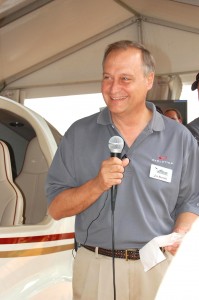
Lancair President Joe Bartels unveiled the company’s most technologically advanced kit plane. The Evolution, a turboprop with a range of 860 nautical miles, is capable of climbing to 28,000 feet.
He added that Blakey played a pivotal role in resolving pilots’ medical certification issues and in pushing for an effort that EAA started 13 years ago: the sport pilot and light-sport aircraft.
“You’ll never know what she had to do to win approval for those initiatives,” he said. “Marion deserves the credit and will leave a legacy that will enhance the future of aviation.”
Blakey made a surprise announcement during the session.
“The FAA will reduce the size and simplify the geography of the Washington Air Defense Identification Zone,” she said.
The new zone eliminates the so-called “Mickey Mouse ears” that described the trio of circles pushed together, creating the complex shape of the old ADIZ. It creates a nearly perfect circle 30 nautical miles across, centered on Washington.
“Score one for GA,” she told a happy crowd that loudly applauded the decision.
The reconfigured restricted area will remove 1,800 square miles of air space from the former ADIZ and lifts restrictions on 33 GA airports from the zone’s coverage.
“The existing ADIZ was put together in haste in the post-9/11 era, and its complex geography resulted in many unnecessary violations,” Blakey said.
The new ADIZ takes effect on Aug. 30. Blakey said it was shaped based on consultation with aviation groups and 20,000 comments received from the public when the Notice of Proposed Rulemaking was issued two years ago. It was put in place without the opportunity for public comment.
“The FAA acted on the requirements of the security agencies and the Department of Defense,” she said. “None of us here questions the need to protect our nation’s capital and everything it stands for.”She said that the creation of four air traffic control positions at the Potomac terminal radar control center, which will be dedicated to handling ADIZ traffic, would help prevent unintentional violations of the new airspace.
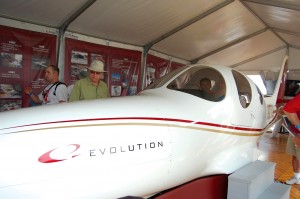
The Evolution is a four-place pressurized aircraft. The cost will be about $250,000 for the kit, minus engine.
“It’s the right thing to do, and the right time to do it,” she said.
Blakey believes the extra attention and the simplified geography will enhance security by allowing staff to concentrate on those who appear to be intentionally violating the space. The nearly perfect circular ADIZ has one imperfection. A triangle notched out of the northwest section allows busy Leesburg Executive Airport (JYO) in Virginia to be exempt from the ADIZ.
Neither Blakey nor Poberezny shied away from mentioning the user fee debate, a hot-button topic among GA pilots.
“As evidenced by the ‘No to User Fees’ badges and decals I see here, we know where we stand,'” Poberezny said during his introduction of Blakey. “The issue now is before Congress. It’s been an honest debate.”
A polite crowd let Blakey speak as she gave one last pitch for the implementation of a GA user fee. She suggested that Congress’ failure to implement a “cost-based” system of generating revenue could result in blocks of airspace being closed to GA.
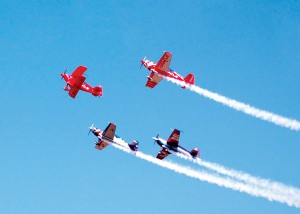
“The Collaborators” features Sean Tucker in the Oracle Challenger, Bill Stein flying an Edge 540 and Eric Tucker and Ben Freelove in Extra 300Ls.
“There’s a very real possibility you won’t be able to fly where you want and when you want,” Blakey said. “We believe a cost-based system will keep you flying rather than keep you from flying.”
She told the audience that under her administration’s proposal, the majority of GA operators wouldn’t be affected.
Poberezny held his ground saying, “GA will win this war.”
Blakey also reflected on her five years as administrator and noted some accomplishments. The wait time for processing flight medicals, in which some issues are flagged at the local level, has been reduced from a number of months to about three weeks.
She’s happy with the progress of the deployment of Automatic Dependent Surveillance-Broadcast. She said she expected the $1 billion contract initiating the system in the Lower 48 states to be awarded to one of three private sector bidders on Aug. 30. Blakey also said that her term has seen the safest period ever for U.S. aviation.
Surprise visits by Freeman, McGovern and Lovell
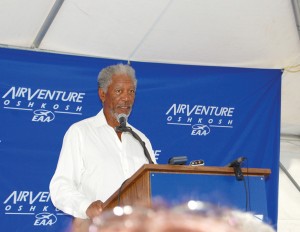
Morgan Freeman spoke with other aviation enthusiasts after a helicopter tour of the AirVenture sprawl on July 26.
Academy Award-winning actor Morgan Freeman, former U.S. Senator George McGovern and Captain James Lovell made surprise visits to AirVenture, earning respect and admiration from the aviators who heard them speak.
Freeman made his first visit to EAA AirVenture on Thursday. He spoke with other aviation enthusiasts after a helicopter tour of the AirVenture sprawl.
“I’m impressed,” he said. “This place is so well organized. Everything has a place and everything is in its place. The people here know what they are doing and do it well.”
Freeman, who was in high school during the Korean War, had an instant answer when someone inquired about his favorite airplane.
“I loved the F-86 Sabre Jet,” he replied. “At 15, I was too young to fly, so I used to fly it from my desk.”
Freeman illustrated by extending his arms and making jet engine noises. He banked a little and then let loose with machine gun sounds—rat, tat, tat, tat—to audience applause.
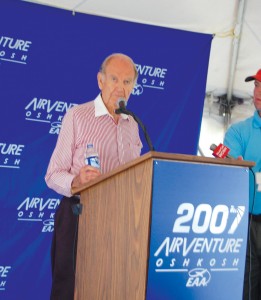
Impressed by his first time at EAA AirVenture, George McGovern called it “the granddaddy of all air shows.” The World War II B-24 bomber pilot reminisced about his wartime experiences.
“On more than one occasion, my English teacher asked, ‘Morgan, what are you doing?’ I had to land quickly,” he said smiling.
During the Korean War, F-86 pilots scored consistent victories over Russian-built MiG fighters. The Air Force created 39 aces, and most came from the F-86 Sabre jet.
“The Sabre jet got me interested in aviation,” he said. “It owned the skies. I wanted to fly and be around airplanes so badly that I went down to the Air Force recruiting station while I was still in high school. The sergeant said, ‘Come back when you graduate; we’ll still be here.’ I did, and they made me a radar mechanic. I was so far away from airplanes all I could see of them was a small blip on the (radar) screen.”
The Air Force offered Freeman a chance at flight school but he would have to reenlist.
“The uniform and I didn’t mix well, so I got out.”
In the decades that followed, Freeman concentrated on his movie career. After Bill Luckett, his business partner in a restaurant and blues club, encouraged him to fly, Freeman took his first lesson in July 2002. He got his license and first plane that October, when he was 65. He added his instrument rating in May 2003, and his multi-engine rating that June.
“I was soon moving up to bigger and faster planes,” he said. “I especially like faster planes.”
In fall 2004, he was checked out to fly his pressurized Cessna 414. He also owns a Cessna Citation 501SP, which he flew to Oshkosh. While he enjoys flying, it didn’t always come easy.
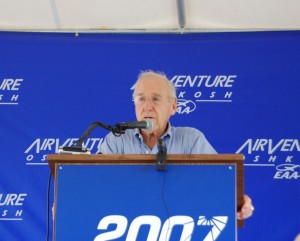
Capt. James Lovell introduced the movie, “Apollo 13,” at the Theater in the Woods on July 26. Lovell, played by Tom Hanks in the movie, served as a technical consultant and, along with his wife, made a cameo appearance.
“The hardest part for me in the beginning was learning how to talk to the air traffic controllers,” he said. “I didn’t understand anything after they said ‘clearance. But now I can do it.”
Freeman revels in his ability to just pick up and fly anytime, anywhere.
“There’s nothing like flying private (vs. commercial) these days,” he said. “Just put the family in the car, drive to the airport, get aboard the airplane and go. It sure beats strip searches.”
He said he’d like to fly various aircraft—including some on the field at AirVenture.
“But the one I’m really looking at these days is the Sino Swearingen jet,” he said. “It’s the only jet that has everything I want in a plane. It goes Mach .87, coast-to-coast nonstop, gets up to 49,000 feet, and will seat me and six passengers.”
His first time at EAA AirVenture impressed McGovern.
“It’s the granddaddy of all air shows,” he said. “It’s gigantic and obviously well run.”
The World War II B-24 bomber pilot reminisced about his wartime experiences. McGovern flew 35 combat missions in B-24 bombers over Germany, Austria, Romania and Yugoslavia during World War II. He won the Distinguished Flying Cross in his plane, the Dakota Queen, named after his bride, Eleanor.
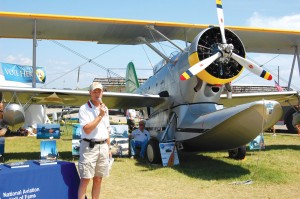
Ron Kaplan, executive director of the National Aviation Hall of Fame, introduces the first “Best of the Best” People’s Choice Award.
“I was very lucky to get out,” said McGovern, now 85. “I have a keen appreciation that I’m still alive. I survived at a time when half of the B-24 crews in that theater didn’t make it.”
McGovern recalled that on one flight, while returning from a bombing mission, a crewmember called on the intercom and said one bomb was dangling out of the rack.
“I said, ‘Get rid of it.’ I wouldn’t land until it was off,'” he recalled.
As the crew attempted to dislodge it, McGovern flew the bomber lower so they could work without their oxygen masks. Then, in the middle of an Austrian farmyard, the bomb dropped.
“The rules at the time were to drop it on any target of opportunity, civilian or military,” he recalled. “In those days, bombing civilians was the norm. Both sides were doing it.”
It was around noon and McGovern knew the whole family would be sitting down to lunch.
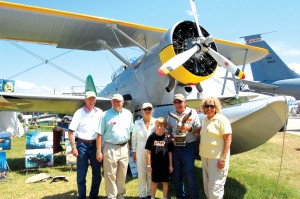
L to R: NAHF enshrinees Joe Engle, Steve Fossett and Patty Wagstaff share a proud moment with Chuck & Bev Greenhill and their grandson Kyle. Oshkosh spectators voted the Greenhill’s 1939 Grumman Duck “Best of the Best.”
“The house was blown to splinters, and we scooted out of there,” he said. “I wondered over the next few years what had happened to the family: did we kill them all or were there any survivors? It kept me up for years at nights.”
McGovern got his answer 40 years later while visiting a professor at an Austrian university.
“I made some inquires and discovered that the family who lived in the house survived,” he said. “I met them, and they told me that they had heard us coming and ran to a ditch they had dug for just such a purpose.”
McGovern was even more surprised by what they told him next.
“They told me that they had no bad feelings toward me or my crew,” he said. “They said if what we did helped advance the Allies and end the war one day sooner, it was worth it.”
Jim Lovell is no stranger to space or to AirVenture.
“I’ve been here many times,” he said.
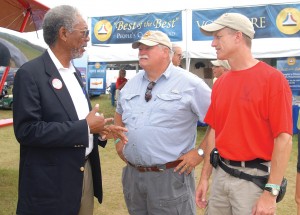
L to R: Morgan Freeman, Alan Hoeweler and NAHF Executive Director Ron Kaplan visit in the NAHF/Rolls-Royce Best of the Best area. Hoeweler’s 1927 Waco 10T was one of five competing aircraft.
He’s also a longtime friend of EAA founder Paul Poberezny.
“I first met Paul in the early ’70s,” he recalled.
Lovell had flown a NASA T-38 into Milwaukee’s Mitchell Field in December for a family visit and parked the aircraft at the Air National Guard base. When he returned that evening, he was about to climb into the cockpit when Poberezny, then a colonel in the Wisconsin Air National Guard, stopped him.
“Son, have you checked that wing?” Lovell quoted Poberezny. “I ran my hand over the wing and it had all sorts of clear ice on it.” After a night in a warm hangar, Lovell departed safely the following morning.
Lovell, best known as commander of the ill-fated NASA Apollo 13 mission, introduced the movie, “Apollo 13,” at the Theater in the Woods on Thursday. Lovell, played by Tom Hanks in the movie, served as a technical consultant and, along with his wife, made a cameo appearance.
“Apollo 13 was my most challenging flight,” Lovell said. “It was a classic case of crisis management; a case of how aircraft accidents begin—through a series of incidents; and a case where good leadership, teamwork, perseverance and initiative were the attributes that got us back home safety.”
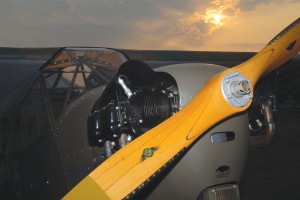
A Piper Cub entered in the competition sits in the early morning sun next to AeroShell Square. Colin and June Powers own the Piper.
Prior to Apollo 13, Lovell flew with fellow astronaut Frank Borman on Gemini 7, a two-week mission in 1965, to research long-duration space flight. He also flew with Edwin “Buzz” Aldrin on Gemini 12, a mission to research extravehicular activity.
“Everybody forgot Newton’s Third Law of Motion: for every action, there’s an opposite and equal reaction,” he said. “We were fighting zero gravity, rather than using it to help us.”
According to Lovell, his third mission, Apollo 8, was his most important. Accompanied by astronauts Frank Borman and William Anders, Lovell went to the moon and back after NASA changed the parameters of the mission in order for the U.S. to reach the moon before the Soviet Union.
Lovell also has years of GA experience. He started flying in 1953 and earned his Navy wings in 1954.
“I’ve flown every month since that time, except when I retired from the Navy and for 16 months following my retirement,” he said. “During that period I got withdrawal symptoms.”
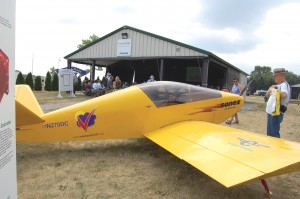
During Sonex Aircraft’s announcement about its AeroConversions division’s E-Flight Initiative, the company unveiled a POC 80-hp-equivalent electric power plant installed in a Waiex airframe.
Lovell smiled and said that he planned to buy a single-engine aircraft, but his wife shot down that plan. Instead, he accommodated her by purchasing a Cessna 310. Five years later he upgraded to a quarter-share in a Cessna 441 Conquest turboprop—an airplane he and his partners later sold. For the next 20 years, Lovell flew a Beech Baron E55 until upgrading to the Cessna 421 Golden Eagle he still flies today.
Sonex goes green
Sonex Aircraft, LLC made a major announcement about its AeroConversions division’s E-Flight Initiative, started in 2006 to pioneer alternative energy research and development for sport aircraft engines. The announcement included the unveiling of a POC 80-hp-equivalent electric power plant installed in a Sonex Waiex airframe.
“This addresses the grass-roots research that’s important to the integrity of EAA and the homebuilt movement,” said Tom Poberezny. “More importantly, it’s growing aviation by making it more economical.”
The proof-of-concept aircraft, expected to fly later this year, will be used to further develop the motor, along with the requisite control systems, charging and battery systems.
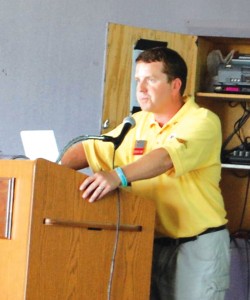
Sonex CEO Jeremy Monnett said that the E-Flight Initiative has three major areas of focus: electric power, ethanol fuel and engine efficiency enhancements. He hopes these initiatives will lead to long-term “green” power plant solutions.
“It was obvious that once we started down this path to developing an alternative power source for the airplane, we had to do it in very specific steps,” said John Monnett, Sonex founder and president, while introducing the electric plane. “The whole object of the proof-of-concept is to come up with a power plant that’s equivalent in weight and in power to our AeroVee-powered Sonex and Waiex models.”
Monnett reiterated that the sole mission of the airplane displayed at AirVenture is to develop the alternative technologies that will ultimately result in production systems. The testbed airplane is also expected to test other, yet unspecified, electric power sources.
According to Jeremy Monnett, Sonex CEO, the E-Flight Initiative has three major areas of focus: electric power, ethanol fuel and engine efficiency enhancements. This diverse approach to the problems of rising energy costs and the environmental effects of burning fossil fuels will provide near, intermediate and long-term “green” power plant solutions.
“Addressing the first focus area, Sonex has developed a prototype brushless DC cobalt motor that’s the size of a coffee can and weighs only 50 pounds,” he said.
Sonex has developed a proprietary electronic motor controller and lithium-polymer battery system to run the AeroConversions electric engine for about one hour under normal flight conditions. The AeroConversions motor is scalable; the core’s design has modular sections that can be reduced to a lower-output, smaller (shorter in length) motor or vice versa.
The 200-amp motor is 90 percent efficient and operates on 270 volts of direct current electricity, as advertised by the Waiex tail number, N270DC.
John Monnett pointed out that a couple of technologies are key to making electric flight a reality.
“Of course we need powerful and light batteries, but a motor controller capable of managing the high power involved also is required,” he said. “A charging system, capable of replenishing the batteries in a reasonable amount of time, is necessary. Sonex is developing both technologies.”
The target flight duration for the POC airplane is 25 to 45 minutes. Production motors are expected to allow for one-hour flights. The company says an hour’s endurance is a challenge right now but is ultimately possible as both the system and the available technologies are further developed.
Meanwhile, Sonex has begun testing to optimize the AeroConversions AeroVee 2.0 to run on a blend of up to 85 percent ethanol with 15 percent gasoline (E85). Ethanol-based fuels burn cleaner than fossil fuels. They’re also testing an engine run at a higher compression for E85 and other blends.
The piston engine is equipped with a versatile carburetor and an ignition system that allows the engine to be configured for higher-compression ratios to optimize the performance for ethanol-based fuels.
Return of the Beach Boys
One of the most recognizable acts in music history, the Beach Boys, returned to AirVenture this year for an encore performance. Their popularity, garnered by selling more than 100 million albums over the past four decades, had AirVenture visitors rocking to the endless sounds of summer by the group that invented the California surfing sound in the early 1960s. The opening day performance was free to all AirVenture guests.
“Last year’s Beach Boys concert was successful beyond all expectations, and we had many requests by EAA members and others for another opening day concert,” said Poberezny.
The 2006 concert, held under threatening skies, drew more than 10,000 people. This year’s concert, under clear skies with moderating late afternoon temperatures, drew an estimated 20,000 guests. Fans began camping out in front of the VIP fence as early as 2 p.m., for the 5:30 show, which lasted two hours. The concert closed with the group singing “Fun, Fun, Fun” which aptly described everyone’s experience—during the concert and throughout the week.
Pearl Harbor survivor is People’s Choice at AirVenture
Five of the world’s finest restored vintage aircraft arrived at AirVenture to vie for top honors in the first National Aviation Hall of Fame “Best of the Best” People’s Choice Award competition.
Participating aircraft must be at least 45 years old, restored to airworthy condition and be a flying museum piece. Voting began on Monday at the NAHF booth at AeroShell Square and ended Saturday morning.
The event is a friendly competition open to former recipients of the NAHF Rolls Royce Aviation Heritage Trophy or Hall of Fame People’s Choice Trophy, or from one of three competing category trophies: antique, classic or warbird.
The original Best of the Best roster of competitors had included the 1941 Lockheed P-38F Glacier Girl and a 1939 Spartan Executive. However, an unanticipated duel engine change and recent landing gear collapse, respectively, scrubbed the two from the inaugural contest.
Five airplanes competed for the award: a 1927 Waco model 10-T, 1930 KR-21 Challenger, 1943 Piper L-4H, 1949 North American Texan and 1939 Grumman Duck.
The Best of the Best display was prominently located at the north end of AeroShell Square, offering guests of AirVenture the opportunity to take a close-up look at each restoration, complete a ballot and vote for their favorite at the NAHF tent.
“Each of the five participating aircraft has previously been deemed by a panel of NAHF judges to be extraordinary examples overall in their class,” explained Ron Kaplan, executive director of the NAHF. “They’re among the finest aircraft flying; however, the ‘People’s Choice,’ as determined by AirVenture’s discerning enthusiasts, will ultimately decide which one earns distinction as the ‘Best of the Best.'”
He said the event offers the NAHF the unique opportunity to weave the colorful history of its pioneers of flight into the tapestry of today’s aviation world.
“We’re delighted to have several of our own aviation legends here to present the winner their honor and trophy,” he said. “The People’s Choice voting also enables each of us at Oshkosh the chance to salute the dedication and passion of the people involved in keeping this history alive and flying.”
The winner was the 1939 Grumman Duck, owned by Charles and Beverly Greenhill of Libertyville, Ill. The aircraft is a survivor of the attack on Pearl Harbor, and is reported to have flown on Dec. 7, 1941, to search for the enemy fleet and engage the enemy, if possible. During its postwar life, it sank in Lake Killarney, Bahamas, in 1955. It rested there in 35 feet of water until recovered in 1991.
The Greenhills acquired the project in 1998, and enlisted Wichita Air Services to undertake its meticulous restoration to airworthy, original condition. Completed in 2005, it’s only one of three flying out of nine known to exist.
The Greenhills accepted their “Best of the Best” People’s Choice Trophy from three pioneers of flight who are also NAHF enshrinees: aerobatic champion Patty Wagstaff, astronaut Joe Engle and world adventurer Steve Fossett.
- The Beach Boys returned for an encore performance at this year’s AirVenture.
- Courtney Long of Pottstown, Penn., watches the Beach Boys concert from her perch on top of an airplane.
- An estimated 20,000 fans gathered on AeroShell Square for the Beach Boys concert.
- The Goodyear Blimp’s last visit was in 1998. Using its more than 165,000 LEDs, the airship flashed “Follow me to Oshkosh” to aviation enthusiasts below.
- The new control tower, under construction, will be almost twice the height of the present tower. It may be ready for AirVenture 2008.
- AeroShell Square rolled out the welcome mat for this C-5A Galaxy from Wright Patterson AFB, 445th Airlift Wing. The gaping maw of the C-5 can swallow up at least three Blackhawk helicopters.
- The Cirrus G3 is the latest version of the SR22 and boasts almost 700 changes. The G3 has a new wing and a carbon fiber spar, which should reduce the weight by about 50 lb.
- Michael Goulian flies the Castrol Aviator Extra 300SHP, the world’s newest custom-built premiere aerobatic aircraft.
- L to R: Angie Cox, Mika Richardson, Dan Gryder, Julie Boatman and Denise Waters were some of the guests at the Women in Aviation Celebrity breakfast.
- Sergei Boriak, in his Sukhoi Su 31, takes off in front of Duggy the DC-3. He won the 1984 U.S.S.R. Aerobatic Championship and was the 1986 World Aerobatic Champion and 1994 German National Champion.
- Warren Pietsch began to modify his 1946 Taylorcraft in 1980, reducing the wingspan 14 feet to become a Clipped Wing Taylorcraft. His aerobatic act has a combination of classic and gyroscopic aerobatic maneuvers.
- Kent Pietsch, in his 1942 Interstate Cadet, flies a comedy act that includes extreme maneuvers, such as the aileron falling off in midair, and a simulated wing contact with the ground.
- A Customs and Border Protection Blackhawk helicopter simulates a fast-rope apprehension of a suspect. CBP had a number of aircraft at this year’s show.
- A major thrill for the audience was the appearance of the F-22 Raptor, the latest stealth fighter in the U.S. Air Force. The Raptor made several high-speed passes and a low-speed pass with its weapons bay open.
- Mike Keenum climbs down from his Sea Fury, Riff Raff. A pilot since 1984, he’s owned and flown numerous aircraft and has more than 10,000 hours of flight time.
- The Heritage Flight has been performed as a tribute to the Air Force since 1997. This year’s formation consisted of an F-22 Raptor, an F-86 Sabre and the P-38, Glacier Girl.
- The Liberty Parachute Team opens every show at AirVenture. There are eight members on the team and the last one down carries the Stars and Stripes.
- An Air Force F-15 punches a hole in the skies over Oshkosh, Wis.
- AeroShell lead pilot Alan Henley, in his T-6, has been performing in air shows since 1980. He soloed at the age of 16 and has flown more than 90 different airplanes, ranging from the Piper Cub to the P-51 Mustang.
- AeroShell Square can hold a lot of heavy metal, such as this giant C-5A Galaxy and, to its left, a C-130 Hercules.
- A man and his grandson make a wing in the woodworking forum, one of more than 100 forums and workshops.
- Jerry Selgers has been entertaining AirVenture visitors on the corner of Knapp Street and Vern Street for more than 20 years. The one-man band uses about a dozen instruments and some electronic enhancement.
- Patty Wagstaff, flying a Cirrus Extra 300S, was the top scoring American pilot at the World Aerobatics Championship in 1996.
- This Consolidated B-24 bomber was one of more than 20,000 built. Out of the four that still exist, this is one of two original equipment examples left.
- Almost 12,800 Boeing B-17 Flying Fortress heavy bombers were made during World War II. At the end of the war, most were scrapped. Of 43 left worldwide, 23 are museum pieces; about one-fourth are flying and the rest await restoration.
- The more than 2,600 show planes are placed on the flight line, where visitors can admire them.
- The heavy lifter C-17 demonstrated its ability to back up on the runway before doing a number of low flybys.
- Captain Julie Clark and author Ann Cooper signed book copies at the Author’s Corner. Cooper and Clark coauthored “Nothing Stood in Her Way,” Clark’s biography.
- An overhead view of AeroShell Square highlights the U2 spyplane and the USAF C-17 Globemaster.
- Angela West conducts a press conference to relate details for the upcoming Gathering of Mustangs and Legends to be held in Columbus, Ohio, Sept. 27-30.
- CBS “Early Show” anchor Dave Price interviews veteran air show pilot Bill Leff during a national broadcast that recounted Leff’s narrow escape en route to Oshkosh. His T-6 lost power, forcing him to land on a highway.
- In their T-28 Trojans, Ralph Glasser (background) and Jack “Skids” Mitchard make an opposing pass during warbird flights at the daily air show. Glasser and Mitchard are Trojan Horsemen Team aerobatic soloists.
- Michael Goulian’s Extra 300SHP is lighter, faster and more maneuverable than any other aircraft of this type. Michael worked with Extra Aircraft of Europe to develope this one-of-a-kind.











